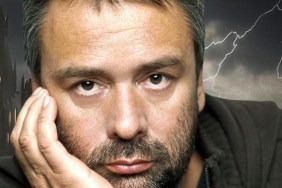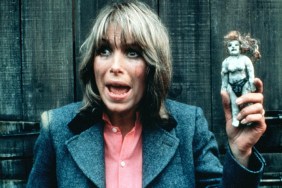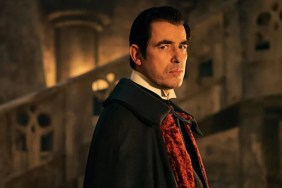
SHOCK takes a brief, critical look at Hammer’s original 9-picture Dracula film series.
When England’s Hammer Studios invested some of their capital and produced 1957’s full-color, full-blooded, adult-geared riff on the classic Universal horror film with Terrence Fisher’s THE CURSE OF FRANKENSTEIN, they changed the way we watch horror movies. Filled with sadism, cruelty, sexuality and gore, but classed-up with sumptuous production values and classically trained British actors in lead roles, CURSE was an international hit and launched a successful (and really, rather wonderful) series of Hammer Frankenstein pictures.
But it was with their next picture, 1958’s HORROR OF DRACULA (known in the UK as simply DRACULA) that they found their first real deal iconic franchise and shone a light on their most memorable horror movie star, Christopher Lee, who was under wraps as the cataract-eyed monster in CURSE, but here was given free reign to terrify and seduce an entire generation of fright fans.
SHOCK takes a brief, critical look at the strange, beautiful, bloody and often, bloody frustrating series of Hammer horror films starring the King of the Vampires.

HORROR OF DRACULA (1958)
Terrence Fisher’s majestic, lean and urgent riff on Bram Stoker’s novel was a bloody punch to the face to Tod Browning’s gentle, mannered 1931 film, effectively replacing Bela Lugosi’s fangless Eurpean gentleman with Christopher Lee’s snarling, athletic and imposing man in black. The film begins with a bang, with cameras prowling over the set of Dracula’s castle, with jets of blood squirting sexually over his coffin and James Bernard’s now-iconic score roaring on the soundtrack. There’s not much to complain about in this maiden voyage as HORROR set the tone for the wave of tough Hammer Gothics to follow and was rarely bettered, with Fisher at the peak of his craft here. That said, the film doesn’t feel as epic as one might hope, with the geography between London and Transylvania fuzzy as, due to budgetary restraints, it’s often clear the actors are just jumping between sets. Lee is perfection of course, effortlessly cool, fluid and dangerous and Peter Cushing sculpted what is still the definitive screen Van Helsing, here portrayed as a less bonkers riff on Sherlock Holmes, a role Cushing would take on a year later in Hammer’s THE HOUND OF THE BASKERVILLES.

BRIDES OF DRACULA (1960)
Lee opted to sit this Fisher-directed sequel out, afraid of being typecast and truthfully…the film does not suffer for the lack of his presence. In fact BRIDES is one of the best Hammer films of all time and one of the strongest in their DRACULA cycle. The title implies that the focus will not be on the Count this round, rather his “Brides”, as in “Brides of Christ”, nuns, the “wives” of a parasitic messiah. Which is interesting, considering the vampire or “bride” we follow here is one Baron Meinster (David Peel), a preening, cackling brat of a ghoul with a very toxic and unhealthy relationship with his long suffering mother. Yes, the homerotic subtext of BRIDES has been talked about ad nauseum but it’s an interesting one (though calling Meinster bisexual would be more appropriate). Peel’s blonde, effete and mean spirited aristocrat revels in his bloodsucking ways and he’s wildly manipulative and resourceful. In HORROR OF DRACULA, Lee’s Count, for all his majesty, was rather easily dispatched. But Meinster gives Cushing’s Van Helsing a real run for his money and the battles between the two opponents are action packed and exciting. The best of them sees Meinster bite Van Helsing, leaving him to be turned, causing the terrified vampire killer to cauterize his infected neck with a hot iron and cool holy water! Fisher directs like a bat out of hell, the movie looks sumptuous and it’s an incredibly eccentric and entertaining example of Hammer at its best.

DRACULA: PRINCE OF DARKNESS (1966)
Eight years after re-inventing the way in which the world would view the character of Dracula, Lee returned to Hammer’s franchise with their first Drac film in 6 years, another winner helmed by the great Terrence Fisher and one in which, strangely, the Count is mute. Depending on who you believe, the role was either written without dialogue to save the production some dough or, as Lee tells it, the script was so chock full of cringe-worthy lines that Lee himself opted to play it silent. One of the lines Lee said he balked at was Dracula saying “I am the apocalypse!”, which I kinda like and wished they had kept. Otherwise, Lee playing the role without dialogue turned out to be a masterstroke, accidental or by intent, it matters not. Without words, Lee relies exclusively on his imposing physical presence (as he did in both THE CURSE OF FRANKENSTEIN and THE MUMMY), a hissing reptile like monster, an alien presence that is to be feared and loathed. This is a mean, violent picture. And those worrying about the lack of Cushing’s Van Helsing needn’t fear as Andrew Keir’s crusading holy man is just as compelling an opponent. There’s also a lot more overt, as in the scene where Dracula opens his chest and urges his female victim to drink his blood, an obvious nod to fellatio.

DRACULA HAS RISEN FROM THE GRAVE (1968)
One of the most underrated Hammer Dracula pictures, GRAVE is a lively affair, directed with style and a leaning towards psychedelia (dig those Dracula-gels!) by veteran Hammer director and award winning cinematographer Freddie Francis. Here, Dracula is woken from the ice prison he fell into in PRINCE OF DARKNESS by a wayward Priest who then becomes Drac’s familiar. Eventually, the Count’s coffin ends up in the cellar beneath a local tavern, where Dracula uses his powers to draw women down to him. Lee has less to do here but he’s still the spine of the film, a movie that is in fact a bit more, dare we say, intellectual than most of the DRACULA films? Conversations about the existence of God and a central dynamic and sub-conflict in which one of the heroes is a pious man, the other an atheist, adds much needed substance to a series of films that usually lack any conflict beyond the morally one-dimensional good vs.evil. A vibrant, classy Drac picture that strangely, despite its bloodshed and headier themes, was rated ‘G’ in the U.S. upon release.

TASTE THE BLOOD OF DRACULA (1970)
This film was initially one of a handful of films designed to turn actor Ralph Bates into a major Hammer horror star, TASTE was originally intended to not have Lee in it at all. But when international distributors balked at having a Drac picture without Lee, the studio piled on the dough to bring Lee back. And truthfully, that’s a shame. TASTE has a dynamic first half. It begins during the final moments of GRAVE, when a traveler witnesses Drac’s execution and, after the old vampire bastard turns to dust, the man retrieves a vial of the Dracula’s concentrated blood. After the credits roll, the central tale kicks in, a story of Victorian morality gone rotten, with a cabal of entitled, elite men of society, stepping out for their monthly night of debauchery and hypocritical transgression. At the house of ill-repute they’re playing in, they meet the Black Magic loving Lord Courtley (Bates) who promises them the ultimate thrill in the form a ritual in which they will drink an activated goblet of Drac’s plasma. When the men freak out at the 11th hour, Courtley drinks the gore, has a fit, is beaten to death by the men, cracks apart and then turns into Christopher Lee! From there, Lee just sleepwalks through his part, bumping off and/or enslaving the daughters of the men who he thinks killed his “master” Courtley. It makes no sense. In the original script, Courtley was the ghoul getting his revenge. But why is Dracula so cheesed? These dudes helped revive the Count. He should thank them! That central lapse in lazy logic makes the second half of TASTE a bit of a by-the-numbers snooze,though Peter Sasdy’s direction is perfectly fine, especially during the darker moments in the first reel.

SCARS OF DRACULA (1970)
After TASTE did so well, Hammer rushed another Dracula picture into production, albeit one armed with a lower budget. SCARS OF DRACULA is the first Drac film to get saddled with an R rating, due in no small part to Dracula’s full-blown and unpleasant sadistic streak. Here Lee is the Devil himself, whipping his servant Klove (not the same dandy butler from PRINCE OF DARKNESS, more of a Renfield-esque madman), torturing his victims and even driving a stake into one of his “brides” hearts for no other reason than to juice the film up with some extra gore. SCARS also has no relation apparently to the rest of the films in the series, with Lee being revived by a blood-spitting rubber bat while he lies desiccated in his coffin (and oh, those bats are so wonderfully phony baloney) but is more of an attempt to re-boot the series, with yet another young couple, this one a rather dull pair, running afoul of the mean Count. Lee approved of this film, mainly because of its attempts to lift scenes from the original novel, including the chilling bit where he scales the castle wall. Roy Ward Baker is perhaps not the edgiest of Hammer’s house directors and his more restrained approach is at odds with the film’s nastier elements (a problem that plagued his THE VAMPIRE LOVERS). If Freddie Francis had steered this ship, it would have been a lurid, even dangerous Dracula movie. As stands, it’s still a fun anomaly in the cycle.

DRACULA A.D. 1972 (1972)
Critics and fans scoffed then and some still jeer at director Alan Gibson and writer Don Houghton’s attempts to propel the Dracula series into the modern age and certainly, DRACULA A.D. 1972 is a much campier, sillier picture. But that unbuttoning of the collar works in the film’s favor. With Lee now running rampant in Mod-era London (one of the film’s alternate titles is DRACULA CHASES THE MINI GIRLS), A.D. 1972 is a blast, with groovy music, a luscious Caroline Munro in the cast, a much more urgent and fast-paced narrative and plenty of kinky twists. It’s also great to see the distinguished Lee back in action as Van Helsing’s Great Grandson, stalking the demon who has long plagued his family. Both Lee and Cushing bring the class, while Gibson and his supporting cast bring the sass. Maybe not a good Hammer Gothic, but a plenty fun vintage 70s British horror movie.

THE SATANIC RITES OF DRACULA (1973)
Gibson and Houghton teamed up again for this immediate follow-up to DRACULA A.D. 1972 and the movie has an even worse reputation than its predecessor. Much of this is due to the picture being a public domain eyesore, haunting dump bins and 50-movie collections everywhere in its heavily cut U.S. version, called DRACULA AND HIS VAMPIRE BRIDE. But man, is SATANIC a great film. Propelled by an amazing score by HORROR EXPRESS’ John Cacavas, SATANIC is a deranged and compelling world-domination spy thriller filled with sex and violence and vampirism, with Lee’s revived Count commanding a vampire cult while also serving as the head a shadowy corporation. Yes indeed, Dracula is a capitalist here and it makes perfect sense. His modus operendi is to release a bio-weapon that will infect the world with the black plague, effectively murdering every human being alive. The extra gravitas comes from the concept that, as Cushing’s Van Helsing explains, with Dracula doing this, he is effectively committing suicide; after humanity perishes, no one will be left to revive him and no one will left for him to eat. There’s so many thrills and chills in SATANIC (love the vampire slaves dying in slow-motion in the cellar sequence). More respect needs to be lauded on this fascinating climax to the series.
Except it wasn’t really the climax…

THE LEGEND OF THE SEVEN GOLDEN VAMPIRES (1974)
Sir Run Run Shaw and Hammer teamed up for this oddball commercial disaster, a mutant hybrid of horror film and Kung-Fu action epic and a weird sidebar-cum-coda to the series. Lee sat this one out, by this point vocally disgusted by Hammer’s irreverent treatment of Stoker’s character, and was replaced by John Forbes-Robertson whose truly evil looking Count possesses a 19th century Shaman in China and uses him to resurrect the Seven Golden Vampires, a group of long-fanged, ancient demonic bloodsuckers who lay waste to the land. Luckily, Peter Cushing’s Van Helsing is lecturing in China and agrees to help fight the monsters, with the aid of a family of chop-scokey heroes. Barely released in an insanely edited version in the US as THE SEVEN BROTHERS MEET DRACULA (have you ever seen this cut? It’s totally bonkers…not in a good way!), GOLDEN only started getting the acclaim it deserves when it started showing up uncut on VHS and DVD in the 90s. It’s a spectacular picture, filled with violence, classic Shaw Brothers action, another great turn by Cushing and buckets and buckets of vampiric weirdness. And that James Bernard score! Roy Ward Baker teamed up with Chinese director Change Cheh, and the latter vision clearly is the one bringing the freak value to this party. A must see…but not a classic Hammer Dracula movie.
What’s your favorite Hammer Dracula movie?








